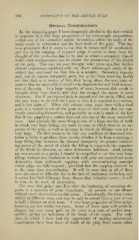Page 876 - My FlipBook
P. 876
886 PATHOLOGY OF THE DENTAL PULP.
General Considerations.
In the foregoing pages I have frequently alkided to the fact—which
is apparent in a very large proportion of my microscopic preparations
—that any of the secondary calcific formations within the pnlj) of the
tooth result in exhaustion and the final death of the pulp. This fact
is so prominent that it seems to me that it cannot well be overlooked,
and yet in the capping of exposed pulps it seems to have been the
thought of the profession that to be able to obtain a secondary dejiosit
under such circumstances was to ensure the permanence of the health
of the pulp. This was my own thought some years ago, but further
clinical experience, combined with the closer microscopic study of the
subject, has convinced me that this is a mistake. Secondary deposits
may, and do, ensure temporary quiet, but so far from ensuring health
are they that, as a matter of fact, they bring about the very state of
matters that we most wish to avoid—the degeneration and final destruc-
tion of the pulp. In a large majority of cases, however, this result is
bi'ought about very slowly, and thus has escaped the notice of most
observers. For if an exposed pulp is capped and the cavity filled, and
the case seems to do well for a year or two, it is regarded as a success,
and is lost sight of. When this returns some years later with a dead
pulp, it is treated as one of the great mass of such cases that are con-
stantly presenting themselves, and probably no note is made of the fact
that it was capped at a certain time and was one of the many successful
cases. And precisely the same thing is true of a large number of teeth
in which very large fillings are made in cases in which there is no ex-
posure of the pulp, as well as in many in which the fillings were not so
verv large. The fact seems to be that anv condition of abnormal irri-
tation is liable to produce these results whether it be from a capping, a
large filling that increases the thernial changes by the greater conduct-
ing power of the metal of which the filling is composed, the exposure
of the fibrils by abrasion, or other deleterious influence. And, taking
my own records as a guide, I should be compelled to say that very large
fillings without non-conductors in teeth with pulp not exposed are more
destructive than well-made cappings with non-conducting material
where pulps are fully exposed provided that the capping material be
;
at the same time non-irritating. It will be seen that in all of these
cases the cause of difficulty lies in the fact of continuous irritation, and
it makes but little difierence from whence that irritation comes ; it will
in time do its work of destruction.
The time that pulps may live after the beginning of secondary de-
posits is a question of great importance. At jiresent we are almost
without exact observation on this point. Undoubtedly, the time varies
\Aidely in different cases, and may be said to extend from a year or two
to half a lifetime or even more. A very large proportion of these pulps,
however, are lost within ten years. Some of these cases will result in
abscess, but very many pass on for years in a state of perfect tran-
quillity, giving no indication of the death of the organ. The only
cases in wliich I have had the o]>])ortunity of making microscopic
examination have been those of death of the pulp from causes other


